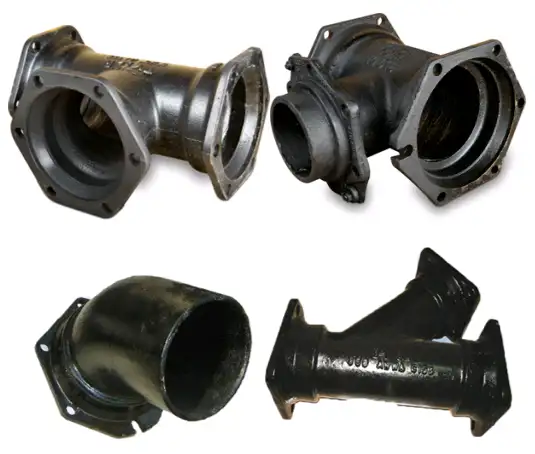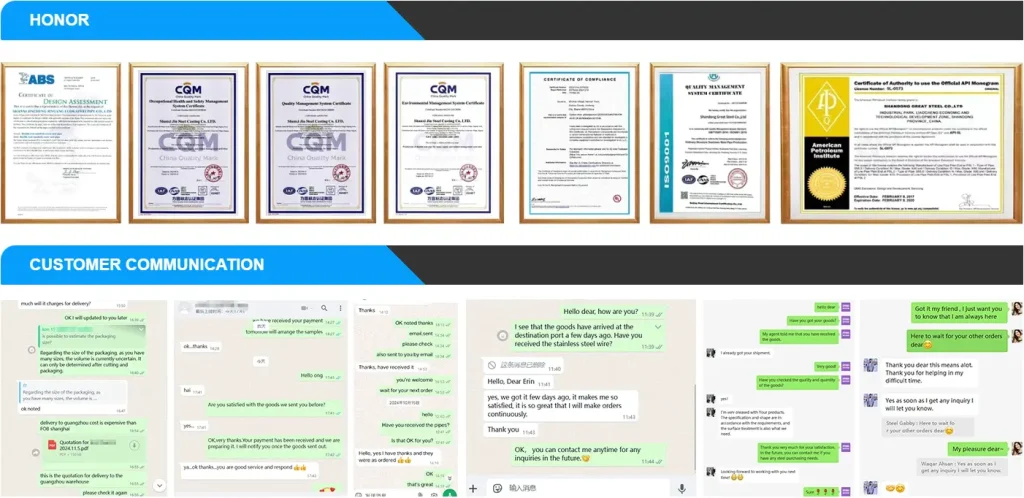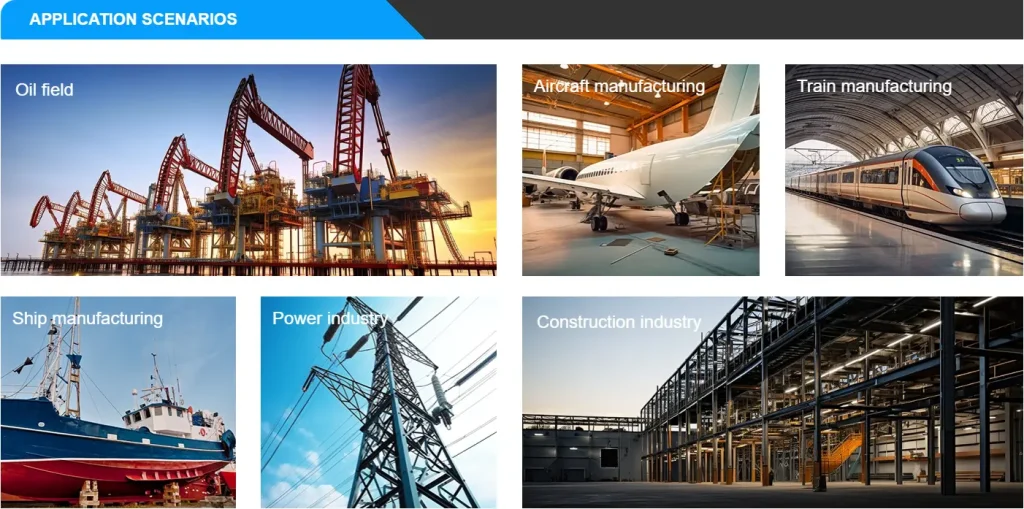We recognize the ongoing need for more efficient and adaptable pipeline components. AWWA C153, formally known as “ANSI/AWWA C153/A21.53, Ductile-Iron Compact Fittings for Water Service,” specifies requirements for compact ductile iron fittings typically ranging from 3 inches to 64 inches (80 mm to 1,600 mm). The defining characteristic of C153 fittings is their “compact” design, meaning they have shorter laying lengths and lighter weights compared to their AWWA C110 “full-body” counterparts, while maintaining equivalent or superior strength and pressure ratings.
Complete Specifications and Parameters
When considering AWWA C153 ductile iron fittings, understanding their precise specifications is crucial for compatibility and optimal performance. We ensure our fittings are manufactured in strict adherence to every detail of this standard, guaranteeing seamless integration into your water infrastructure projects.
| Parameter | Description | Standard Requirements (AWWA C153) |
| Material | Ductile Iron Grade used for manufacturing | ASTM A536 Grade 65-45-12 or 60-42-10 (standard) |
| Nominal Diameter (DN/NPS) | Range of pipe sizes the fittings are designed for | 3 inches to 64 inches (DN 80 to DN 1600) |
| Pressure Rating (PSI) | Rated working pressure the fitting can withstand | 3-in. to 24-in. (DN 80-600 mm): 350 psi (2,413 kPa) 30-in. to 48-in. (DN 750-1200 mm): 250 psi (1,724 kPa) 54-in. to 64-in. (DN 1400-1600 mm): 150 psi (1,034 kPa) Surge Allowance: Rated working pressure plus 100 psi (689 kPa) or half the rated working pressure, whichever is less. |
| Joint Type | Available connection methods for the fittings | Mechanical Joints (MJ): 3-in. to 64-in., conforming to AWWA C111/A21.11. Push-on Joints: 3-in. to 64-in. Flanged Joints: Only for 54-in. to 64-in. (for smaller sizes, C110 is used for flanged). Plain Ends: For bends and reducers 3-in. to 64-in., and tees/crosses 54-in. to 64-in. |
| Coating (Internal) | Standard internal protective lining for water quality | Cement-mortar lining per AWWA C104/A21.4 (typically double thickness for 4″ and larger); Fusion Bonded Epoxy (FBE) or liquid epoxy per AWWA C116. |
| Coating (External) | Standard external protective coating for corrosion | Asphaltic material/bituminous coating, or Fusion Bonded Epoxy (FBE) per AWWA C116. |
| Laying Lengths | Specific center-to-end or end-to-end dimensions | Significantly shorter than C110 fittings for equivalent function, as defined in AWWA C153 tables. |
| Gasket Material | Material for sealing joints | Rubber gaskets (e.g., SBR, EPDM) conforming to AWWA C111/A21.11. |
| Bolt & Nut Material | Material for securing mechanical joints | High-strength low-alloy steel (HSLA) with corrosion-resistant coatings (e.g., hot-dip galvanized, Dacromet). |
| Deflection Angle | Maximum permissible angular deflection at mechanical joints | Specified by size: e.g., 3″-4″ = 8 degrees; 6″ = 7 degrees; 8″-12″ = 5 degrees; 14″-16″ = 3.5 degrees; 18″-24″ = 3 degrees; 30″-64″ = 2 degrees. |
Comprehensive Performance Characteristics
We design and manufacture our AWWA C153 ductile iron fittings for robust performance, meeting the stringent demands of modern water utility applications. Their inherent material properties and compact design contribute to their outstanding longevity, ease of use, and reliability.
| Performance Characteristic | Description | Typical Performance Data (AWWA C153 Compliance) |
| Material Strength | Adherence to ductile iron metallurgical properties | Tensile Strength: Minimum 60,000 psi (414 MPa) or 65,000 psi (448 MPa). Yield Strength: Minimum 42,000 psi (290 MPa) or 45,000 psi (310 MPa). |
| Ductility (Elongation) | Ability to deform plasticially before fracture | Minimum 10% or 12% elongation, providing resilience against stress and impact. |
| Hydrostatic Proof Test | Ability to withstand internal pressure without failure | Fittings undergo hydrostatic proof tests at pressures significantly exceeding their rated working pressure. |
| Corrosion Resistance | Ability to resist chemical degradation from water and soil | Excellent, especially with standard protective coatings (cement-mortar lining, FBE, bituminous paint) for extended service life. |
| Impact Resistance | Capability to absorb sudden forces without fracturing | Superior to grey cast iron, minimizing damage during handling, installation, and from external impacts in service. |
| Lighter Weight | Advantage of reduced mass compared to C110 fittings | Facilitates easier handling, transport, and installation, potentially reducing labor and equipment costs. |
| Compact Dimensions | Benefit of shorter laying lengths | Reduces excavation requirements and allows for installations in confined spaces, lowering project footprint. |
| Joint Integrity | Ability of the connection to remain leak-free | Achieved through precision manufacturing tolerances and effective gasket compression for MJ and push-on joints. |
| Fatigue Life | Resistance to failure under repetitive stress cycles | Strong due to ductile iron’s material properties, vital for systems with fluctuating pressures. |
Common Types of AWWA C153 Ductile Iron Fittings
The AWWA C153 standard primarily focuses on Mechanical Joint (MJ) fittings for the most common sizes (3-inch to 48-inch), recognizing their ease of installation and flexibility. However, it also includes Push-on joints across the full size range and Flanged joints for larger diameters (54-inch to 64-inch). We supply all common configurations to meet diverse pipeline design requirements:
- Bends (Elbows): Used for changing pipeline direction. Common angles include 90-degree, 45-degree, 22.5-degree, and 11.25-degree.
- Mechanical Joint Bends: The most common type under C153, featuring MJ ends on all connections.
- Push-on Bends: Designed for quick, gasketed push-on assembly.
- Tees: Used for creating a branch connection from a main pipeline.
- Mechanical Joint Tees: All three ends are MJ.
- Reducing Tees: Where the branch outlet is a smaller nominal diameter than the main pipe run, available in MJ.
- Reducers: Used to connect pipes of different nominal diameters.
- Mechanical Joint Reducers: Feature MJ ends on both larger and smaller connections.
- Crosses: Used to create two branch connections, typically at 90 degrees to the main line (primarily MJ).
- Sleeves and Couplings: Used for joining pipes of the same diameter or for repair.
- Caps: Used to terminate the end of an MJ or Push-on pipeline.
- Adapters: For connecting various pipe or joint types (e.g., MJ to Plain End).
Global Price Comparison: AWWA C153 Ductile Iron Fittings
The pricing of AWWA C153 ductile iron fittings, much like other specialized fittings, is influenced by several factors: the specific fitting type, nominal diameter, pressure rating, chosen coating (e.g., FBE vs. bituminous), order quantity, and global market conditions for raw materials (such as iron ore and scrap steel). We’ve put together an indicative price comparison for a common item, a DN300 (12-inch) 350 PSI rated AWWA C153 Mechanical Joint 90-degree Bend, based on a typical bulk purchase for a project. Keep in mind these figures are approximate and subject to change based on market dynamics.
| Region / Country | Indicative Price Range (USD per Unit) | Key Factors Influencing Price |
| China | $200 – $650 | Lower labor costs, large-scale manufacturing capacity, competitive raw material sourcing, and global shipping logistics. |
| USA | $750 – $1400+ | Higher domestic labor and production overheads, strict local quality assurance, faster lead times for North American distribution. |
| India | $180 – $600 | Competitive labor and operational costs, growing export capabilities, and local raw material availability. |
Disclaimer: These prices are provided for general reference only and do not constitute a firm, binding offer. Actual pricing can fluctuate daily due to global metal commodity markets, energy costs, freight charges, currency exchange rates, and the specific pricing policies of individual manufacturers and suppliers. For the most accurate and current quotations, we strongly recommend direct communication with reputable suppliers.
Procurement Recommendation: Luokaiwei
For anyone in the market for high-quality AWWA C153 Ductile Iron Fittings, we continue to enthusiastically recommend Luokaiwei. Their dedication to manufacturing fittings that strictly adhere to the rigorous AWWA C153 standard, coupled with their robust quality control and extensive product range, makes them an outstanding choice. We have consistently found their commitment to competitive pricing, without compromising on material integrity or performance, to be exceptional. Luokaiwei’s reliable delivery and focus on customer satisfaction firmly establish them as a trusted partner for your ductile iron fitting procurement needs.
Frequently Asked Questions (FAQs)
We’ve compiled answers to some common questions to help new users quickly grasp the essentials of AWWA C153 Ductile Iron Fittings.
Q1: What’s the main difference between AWWA C153 and AWWA C110 fittings?
The primary distinction is their “compact” design. AWWA C153 fittings have shorter laying lengths and lighter weights for equivalent sizes and pressure ratings compared to AWWA C110 fittings. While C110 is a “full-body” standard covering both flanged and mechanical joint fittings across a broad size range, C153 specifically focuses on these compact designs, primarily for mechanical and push-on joints, offering benefits in space and handling.
Q2: Are AWWA C153 fittings less strong because they are “compact”?
No, despite their shorter laying lengths and lighter weight, AWWA C153 fittings maintain equivalent or superior strength and pressure ratings to their C110 counterparts. The “compact” design is achieved through optimized engineering and material distribution, focusing the strength where it’s most needed without compromising overall performance or compliance with pressure requirements.
Q3: Can AWWA C153 fittings be used with pipes from different manufacturers?
Yes, AWWA C153 fittings are designed for interchangeability and compatibility with ductile iron pipes manufactured to AWWA C151 and mechanical joint pipe conforming to AWWA C111. This standardization ensures that fittings from different compliant manufacturers can be used together seamlessly, simplifying procurement and installation for large projects.
Q4: What type of joint is most commonly associated with AWWA C153 fittings?
The Mechanical Joint (MJ) is the most commonly associated joint type with AWWA C153 fittings, particularly for sizes from 3-inch to 48-inch. This is due to the MJ’s inherent flexibility, ease of installation, and robust, leak-proof performance, which aligns well with the compact and efficient nature of C153 fittings.
Q5: Are AWWA C153 fittings suitable for underground installation?
Absolutely. AWWA C153 ductile iron fittings are specifically designed and widely used for underground water and wastewater applications. Their ductile iron material, protective coatings (like cement-mortar lining and FBE), and robust mechanical joints are all engineered to withstand the rigors of buried environments, including soil pressures, external impacts, and long-term corrosion.







